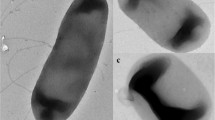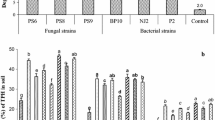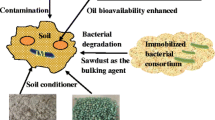Abstract
Heavy contamination of soil with crude oil has caused significant negative environmental impacts and presents substantial hazards to human health. To explore a highly efficient bioaugmentation strategy for these contaminations, experiments were conducted over 180 days in soil heavily contaminated with crude oil (50,000 mg kg−1), with four treatments comprised of Bacillus subtilis inoculation with no further inoculation (I), or reinoculation after 100 days with either B. subtilis (II), Acremonium sp.(III), or a mixture of both organisms (IV). The removal values of total petroleum hydrocarbons were 60.1 ± 2.0, 60.05 ± 3.0, 71.3 ± 5.2 and 74.2 ± 2.7 % for treatment (I–IV), respectively. Treatments (III–IV) significantly enhanced the soil bioremediation compared with treatments (I–II) (p < 0.05). Furthermore, significantly (p < 0.05) greater rates of degradation for petroleum hydrocarbon fractions were observed in treatments (III–IV) compared to treatments (I–II), and this was especially the case with the degradative rates for polycyclic aromatic hydrocarbons and crude oil heavy fractions. Dehydrogenase activity in treatment (III–IV) containing Acremonium sp. showed a constant increase until the end of experiments. Therefore reinoculation with pure fungus or fungal-bacterial consortium should be considered as an effective strategy in bioaugmentation for soil heavily contaminated with crude oil.




Similar content being viewed by others
References
Adam G, Duncan H (2001) Development of a sensitive and rapid method for the measurement of total microbial activity using fluorescein diacetate (FDA) in a range of soils. Soil Biol Biochem 33(7):943–951
Atlas R, Cerniglia C (1995) Bioremediation of petrolium pollutants: diversity and environmental aspects of hydrocarbon biodégradation. Bioscience 45(5):25–40
Bastow TP, van Aarssen BGK, Lang D (2007) Rapid small-scale separation of saturate, aromatic and polar components in petroleum. Org Geochem 38(8):1235–1250
Borole AP, Sublette KL, Raterman KT, Javanmardian M, Fisher JB (1997) The potential for intrinsic bioremediation of BTEX hydrocarbons in soil/ground water contaminated with gas condensate. Appl Biochem Biotechnol 63–65:719–730
Chagas-Spinelli AC, Kato MT, de Lima ES, Gavazza S (2012) Bioremediation of a tropical clay soil contaminated with diesel oil. J Environ Manage 113:510–516
Das K, Mukherjee AK (2007) Crude petroleum-oil biodegradation efficiency of Bacillus subtilis and Pseudomonas aeruginosa strains isolated from a petroleum-oil contaminated soil from North-East India. Bioresour Technol 98(7):1339–1345
Ellegaard-Jensen L, Knudsen BE, Johansen A, Albers CN, Aamand J, Rosendahl S (2014) Fungal-bacterial consortia increase diuron degradation in water-unsaturated systems. Sci Total Environ 466–467:699–705
Hamdi H, Benzarti S, Manusadžianas L, Aoyama I, Jedidi N (2007) Bioaugmentation and biostimulation effects on PAH dissipation and soil ecotoxicity under controlled conditions. Soil Biol Biochem 39(8):1926–1935
Heinaru E, Merimaa M, Viggor S, Lehiste M, Leito I, Truu J, Heinaru A (2005) Biodegradation efficiency of functionally important populations selected for bioaugmentation in phenol- and oil-polluted area. FEMS Microbiol Ecol 51(3):363–373
Husaini A, Roslan HA, Hii KSY, Ang CH (2008) Biodegradation of aliphatic hydrocarbon by indigenous fungi isolated from used motor oil contaminated sites. World J Microbiol Biotechnol 24(12):2789–2797
Llado S, Gracia E, Solanas AM, Vinas M (2013) Fungal and bacterial microbial community assessment during bioremediation assays in an aged creosote-polluted soil. Soil Biol Biochem 67:114–123
Lu M, Zhang Z, Sun S, Wang Q, Zhong W (2009) Enhanced degradation of bioremediation residues in petroleum-contaminated soil using a two-liquid-phase bioslurry reactor. Chemosphere 77(2):161–168
Ma X-k, Ling Wu L, Fam H (2014) Heavy metal ions affecting the removal of polycyclic aromatic hydrocarbons by fungi with heavy-metal resistance. Appl Microbiol Biot 98(23):9817–9827
Machin-Ramirez C, Morales D, Martinez-Morales F, Okoh AI, Trejo-Hernandez MR (2010) Benzo[a]pyrene removal by axenic- and co-cultures of some bacterial and fungal strains. Int Biodeterior Biodegrad 64(7):538–544
Mahmoud DB, Shukr MH, Bendas ER (2014) In vitro and in vivo evaluation of self-nanoemulsifying drug delivery systems of cilostazol for oral and parenteral administration. Int J Pharm 476(1–2):60–69
Megharaj M, Singleton I, McClure NC, Naidu R (2000) Influence of petroleum hydrocarbon contamination on microalgae and microbial activities in a long-term contaminated soil. Arch Environ Contam Toxicol 38(4):439–445
Rahman KS, Rahman TJ, Kourkoutas Y, Petsas I, Marchant R, Banat IM (2003) Enhanced bioremediation of n-alkane in petroleum sludge using bacterial consortium amended with rhamnolipid and micronutrients. Bioresour Technol 90(2):159–168
Rodriguez-Rodriguez CE, Lucas D, Baron E, Gago-Ferrero P, Molins-Delgado D, Rodriguez-Mozaz S, Eljarrat E, Silvia Diaz-Cruz M, Barcelo D, Caminal G, Vicent T (2014) Re-inoculation strategies enhance the degradation of emerging pollutants in fungal bioaugmentation of sewage sludge. Bioresour Technol 168:180–189
Ruberto L, Vazquez SC, Mac Cormack WP (2003) Effectiveness of the natural bacterial flora, biostimulation and bioaugmentation on the bioremediation of a hydrocarbon contaminated Antarctic soil. Int Biodeterior Biodegrad 52(2):115–125
Sabaté J, Viñas M, Solanas AM (2004) Laboratory-scale bioremediation experiments on hydrocarbon-contaminated soils. Int Biodeterior Biodegrad 54(1):19–25
Salminen JM, Tuomi PM, Suortti A-M, Jørgensen KS (2004) Potential for aerobic and anaerobic biodegradation of petroleum hydrocarbons in boreal subsurface. Biodegradation 15(1):29–39
Saraswathy A, Hallberg R (2002) Degradation of pyrene by indigenous fungi from a former gasworks site. FEMS Microbiol Lett 210(2):227–232
Schnürer J, Rosswall T (1982) Fluorescein diacetate hydrolysis as a measure of total microbial activity in soil and litter. Appl Environ Microb 43(6):1256–1261
Söderström B (1977) Vital staining of fungi in pure cultures and in soil with fluorescein diacetate. Soil Biol Biochem 9(1):59–63
Stemmer M, Gerzabek MH, Kandeler E (1998) Invertase and xylanase activity of bulk soil and particle-size fractions during maize straw decomposition. Soil Biol Biochem 31(1):9–18
Tang X, He LY, Tao XQ, Dang Z, Guo CL, Lu GN, Yi XY (2010) Construction of an artificial microalgal-bacterial consortium that efficiently degrades crude oil. J Hazard Mater 181(1–3):1158–1162
Trindade PV, Sobral LG, Rizzo AC, Leite SG, Soriano AU (2005) Bioremediation of a weathered and a recently oil-contaminated soils from Brazil: a comparison study. Chemosphere 58(4):515–522
Vogel TM (1996) Bioaugmentation as a soil bioremediation approach. Curr Opin Biotechnol 7(3):311–316
Xu Y, Lu M (2010) Bioremediation of crude oil-contaminated soil: comparison of different biostimulation and bioaugmentation treatments. J Hazard Mater 183(1–3):395–401
Zhou NA, Lutovsky AC, Andaker GL, Ferguson JF, Gough HL (2014) Kinetics modeling predicts bioaugmentation with Sphingomonad cultures as a viable technology for enhanced pharmaceutical and personal care products removal during wastewater treatment. Bioresour Technol 166:158–167
Acknowledgments
The project was supported by the Fundamental Research Funds for the Central Universities of China (No. GK201402022).
Conflict of interest
The authors declare that they have no conflict of interest.
Author information
Authors and Affiliations
Corresponding author
Rights and permissions
About this article
Cite this article
Ma, XK., Ding, N. & Peterson, E.C. Bioaugmentation of soil contaminated with high-level crude oil through inoculation with mixed cultures including Acremonium sp.. Biodegradation 26, 259–269 (2015). https://doi.org/10.1007/s10532-015-9732-7
Received:
Accepted:
Published:
Issue Date:
DOI: https://doi.org/10.1007/s10532-015-9732-7




